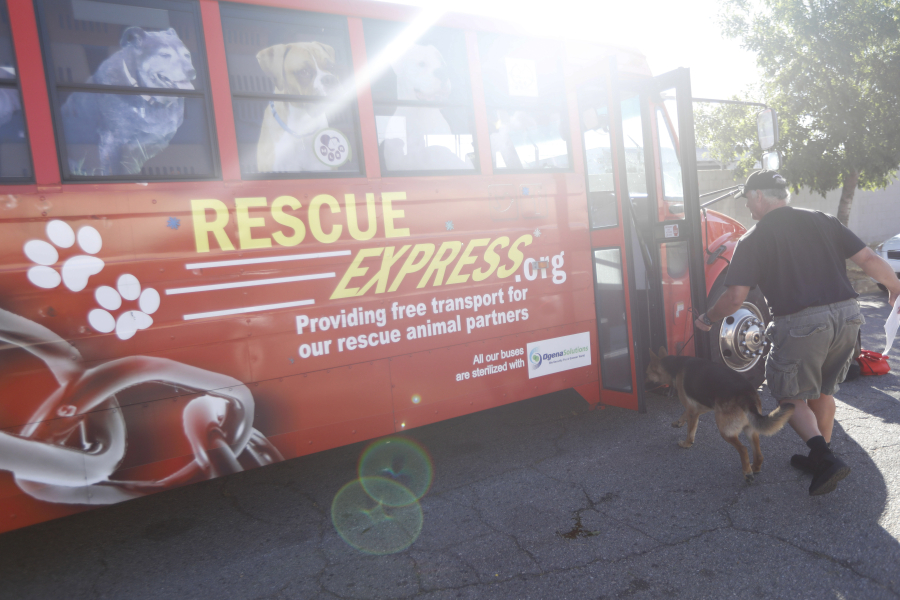SAN FERNANDO, Calif. — May was supposed to be dead by now. The charcoal-and-white pit bull mix had languished for more than two months at a high-kill animal shelter in east Los Angeles County, and though she’d passed one “temperament test” required for adoption, she failed a second. That essentially put her on death row at the facility.
But a small rescue group got to May first and reserved her a spot on a school bus that would take her 840 miles north to Eugene, Ore.; there, another rescue had pledged to find her a home. And so on a sunny Saturday morning, she bounded up the steps of the red bus and quickly settled into a large crate near the back.
She had plenty of company as the wheels rolled along the highway: 105 other dogs and cats collected from crowded shelters in California and destined for the Pacific Northwest, where euthanasia rates are lower and pets are in greater demand. Their four rows of crates were stacked floor to ceiling. “These little souls have engulfed me,” admitted Phil Broussard, the garrulous trucker driving them up the coast.
His passengers were among the more than 10,000 animals that will be ferried out of the area this year by Rescue Express, one of the dozens of organizations across the nation fueling a dizzying daily reshuffle of dogs and cats by car, van, bus, and private and even chartered plane.
These transports, mostly from high-kill southern regions, are small but growing factors in a long-term decline in euthanasia at U.S. shelters. According to some estimates, animal shelters killed as many as 20 million cats and dogs annually in the 1970s. That had fallen to 2.6 million by 2011 and to 1.5 million today, according to the American Society for the Prevention of Cruelty to Animals.
The numbers are only approximations, because no central data collection exists and only some states require shelters to report intake and outcome figures. But animal advocates agree that the decrease in euthanasia has been dramatic, driven mostly by successful spay-neuter programs and, more recently, by savvy adoption campaigns, greater efforts to reunite lost pets with owners and the proliferation of advocacy groups both small and large that have swept in to help municipal shelters, often poorly funded and sluggish.
Progress remains geographically lopsided, too. Advocates point to northern cities’ more concerted spay-neuter campaigns and mention “cultural” differences in attitudes about sterilizing pets. Climate is another factor: In warmer regions, cats go into heat more often, pets are more likely to be allowed outside, and strays more easily survive — all of which lead to more kittens and puppies.
Whatever the reason, shelters and rescue groups say an increasing number of communities in northern parts of the country now take in migrants — young and old, small and large. Nearly a third of the 30,000 dogs and cats received by a Portland coalition of six shelters in 2016 came from outside the area, including from Hawaii.
Today, May, the California pit bull, is hanging out at Northwest Dog Project, the rescue that had agreed to find her a home. Its 22-acre facility usually hosts 10 to 18 dogs at a time in cottages with piped-in music and even skylights. There’s a doggy swimming pool, an agility course, a play yard and hiking trails.
“A majority of the dogs we take in come from high-kill shelters in California, where they’ve been living in noise and chaos. This is a good place for them to decompress,” director Emma Scott explained.



